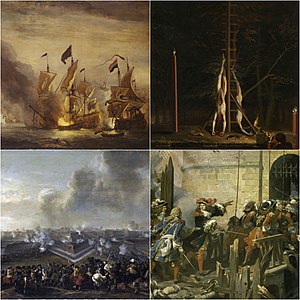
Back Frans-Nederlandse Oorlog Afrikaans الحرب الفرنسية الهولندية Arabic فرانسه و هولند ساواشی AZB Галандская вайна Byelorussian Холандска война Bulgarian Brezel Holland Breton Guerra Francoholandesa Catalan Francouzsko-nizozemská válka Czech Den fransk-hollandske krig Danish Holländischer Krieg German
This article needs additional citations for verification. (November 2021) |
| Franco-Dutch War | |||||||||
|---|---|---|---|---|---|---|---|---|---|
| Part of the wars of Louis XIV | |||||||||
 Left to right: | |||||||||
| |||||||||
| Belligerents | |||||||||
|
| ||||||||
| Commanders and leaders | |||||||||
| Strength | |||||||||
|
|
| ||||||||
| Casualties and losses | |||||||||
| 120,000 killed or wounded[1] | 100,000 killed or wounded[1] | ||||||||
| 342,000 total military deaths[5] | |||||||||
The Franco-Dutch War, also known as the Dutch War (French: Guerre de Hollande; Dutch: Hollandse Oorlog), was fought between France and the Dutch Republic, supported by its allies the Holy Roman Empire, Spain, Brandenburg-Prussia and Denmark-Norway. In its early stages, France was allied with Münster and Cologne, as well as England. The 1672 to 1674 Third Anglo-Dutch War and 1675 to 1679 Scanian War are considered related conflicts.
The war began in May 1672 when France nearly overran the Dutch Republic, an event still known as the Rampjaar or "Disaster Year".[6] Their advance was halted by the Dutch Water Line in June and by late July the Dutch position had stabilised. Concern over French gains led to a formal alliance in August 1673 between the Dutch, Emperor Leopold I, Spain and Brandenburg-Prussia. They were joined by Lorraine and Denmark, while England made peace in February 1674. Now facing a war on multiple fronts, the French withdrew from the Dutch Republic, retaining only Grave and Maastricht.
Louis XIV refocused on the Spanish Netherlands and Rhineland, while the Allies led by William of Orange sought to limit French gains. After 1674, the French occupied Franche-Comté and areas along their border with the Spanish Netherlands and in Alsace, but neither side was able to achieve a decisive victory. The war ended with the September 1678 Peace of Nijmegen; although the terms were far less generous than those available in June 1672, it is often considered the high point of French military success under Louis XIV and provided him a significant propaganda success.
Spain recovered Charleroi from France but ceded Franche-Comté, as well as much of Artois and Hainaut, establishing borders that remain largely unchanged into modern times. Under the leadership of William of Orange, the Dutch had recovered all the territory lost in the disastrous early stages, a success that secured him a leading role in domestic politics. This helped him counter the threat posed by continued French expansion and create the 1688 Grand Alliance that fought in the Nine Years' War.
- ^ a b c d Clodfelter 1992, p. 47.
- ^ Panhuysen 2009, p. 84.
- ^ Shomette & Haslach 1988, p. 31.
- ^ a b Wilson 2016, p. 461.
- ^ Levy 1983, p. 90.
- ^ 1672 Disaster Year Archived 24 April 2016 at the Wayback Machine, Rijksmuseum
Cite error: There are <ref group=lower-alpha> tags or {{efn}} templates on this page, but the references will not show without a {{reflist|group=lower-alpha}} template or {{notelist}} template (see the help page).